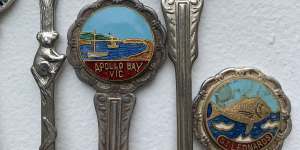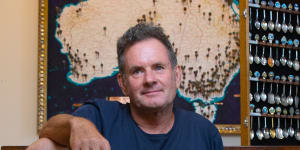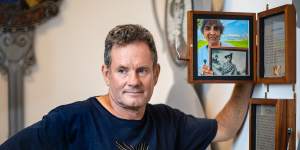We made teaspoons to celebrate Ayers Rock (not Uluru),Apollo Bay,The Man From Snowy River and even the Healesville Sanctuary,symbolised by a little silver platypus.

A slice of Australiana.Simon Normand
For artist Simon Normand,those sometimes striking,sometimes tacky reminders of the towns that dot the bush or the beach hide something darker.
“They are all beautiful locales with horrible histories,” said Normand,60,an artist who has travelled to Arnhem Land to engage with local Aboriginal cultures for decades. “They can be beautiful looking,but when we open them up they can be not so beautiful.”
A chance discovery at his mother’s house of a teaspoon celebrating the bulldozing of an old-growth forest at Cann River in East Gippsland led him to create an art installation.
Teaspoon Colony uses 24 giant mosaic and steel forged teaspoons to examine our colonial settlements and their disturbing histories.

Simon Normand at his Teaspoon Colony exhibition at the Australian Galleries in Collingwood.Simon Schulter
The oversized teaspoons are made of hammered and laser cut steel,powder coated in silver,while the trim is decorative wrought iron. The mosaics are Venetian glass rather than the familiar enamel.
“I went down a teaspoon rabbit hole of really trying to find out what it is that people thought was important about different eras in the same place,” Normand said.
His Indigenous friends would give him teaspoons for places – such as Tennant Creek in the middle of the Northern Territory – that Normand never imagined would have commemorative memorabilia.
“And they would tell me the stories about what they thought was the most important thing about those places,and I would tell them what I thought was most important about those places. And the differences were remarkable,” he said.
“That’s when I thought this was a really good vehicle to illustrate all these stories that were told to me.”
Normand’s exhibition presents oversized maps of Australia that use teaspoons to demarcate First Nations boundaries. Giant souvenir teaspoons sit next to wooden information boxes,which open up to reveal alternative histories from an Aboriginal perspective.
Mataranka in the NT is home to gorgeous hot water springs with palm trees that are nationally famous – but Normand’s history tells us of nearby Aboriginal burial sites destroyed by mining.
“Souvenirs use recognisable images to remind us of the location they represent,” Amy Clarke,senior lecturer in history at the University of the Sunshine Coast,.

Simon Normand at his Teaspoon Colony exhibition.Simon Schluter
“The particular images promoted can also reveal a great deal about the cultures that produce and sell them,as well as the tourists who buy them.”
In the era of the selfie,souvenir teaspoons and their cheaper cousin,the postcard,have lost their cachet and relevance. But Normand found they lived on in corners of op shops,Facebook groups and cafes with a vintage feel.
His studio has about 1000 spoons commemorating places named after explorers,settlers and in some cases,murderers.
There are teaspoons of places that no longer exist such as Wittenoom,the now-abandoned West Australian town that was once home to 20,000 people near a deadly asbestos mine.
Stuart Purves,national director of Australian Galleries in Collingwood,programmed the exhibition and hopes to sell it to a cultural institution.
“The integrity of it,the absolute necessity of it – I said,‘Here’s the space,let’s go’,” Purves said. “It is so bleak and desperate – what an appalling history we have got.
“Can you believe how undignified it is that a teaspoon represents your territory? I just think it is a seriously important exhibition.”
Normand remains fascinated by the phenomenon of the tea break.
“You sit down at four o’clock and you’d have tea,and that’s all around the colonies of the world,” Normand said. “This whole idea of taking the time to actually entertain and to sit down and talk and converse with people.
“And that’s vanished now. Melbourne’s tea ceremony has been taken over by Melbourne’s coffee culture.”
The exhibition.
